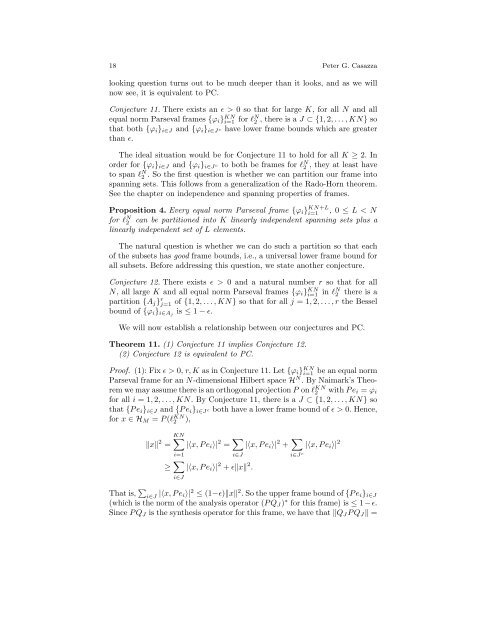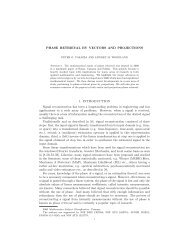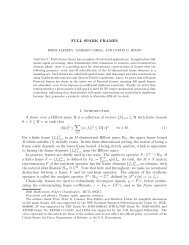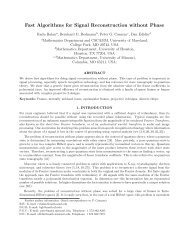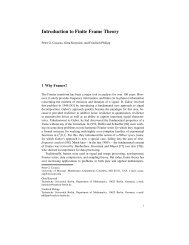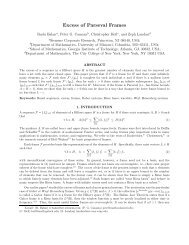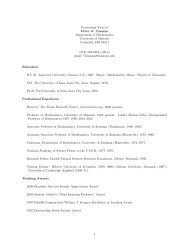The Kadison-Singer and Paulsen Problems in Finite Frame Theory
The Kadison-Singer and Paulsen Problems in Finite Frame Theory
The Kadison-Singer and Paulsen Problems in Finite Frame Theory
Create successful ePaper yourself
Turn your PDF publications into a flip-book with our unique Google optimized e-Paper software.
18 Peter G. Casazzalook<strong>in</strong>g question turns out to be much deeper than it looks, <strong>and</strong> as we willnow see, it is equivalent to PC.Conjecture 11. <strong>The</strong>re exists an ɛ > 0 so that for large K, for all N <strong>and</strong> allequal norm Parseval frames {ϕ i } KNi=1 for lN 2 , there is a J ⊂ {1, 2, . . . , KN} sothat both {ϕ i } i∈J <strong>and</strong> {ϕ i } i∈J c have lower frame bounds which are greaterthan ɛ.<strong>The</strong> ideal situation would be for Conjecture 11 to hold for all K ≥ 2. Inorder for {ϕ i } i∈J <strong>and</strong> {ϕ i } i∈J c to both be frames for l N 2 , they at least haveto span l N 2 . So the first question is whether we can partition our frame <strong>in</strong>tospann<strong>in</strong>g sets. This follows from a generalization of the Rado-Horn theorem.See the chapter on <strong>in</strong>dependence <strong>and</strong> spann<strong>in</strong>g properties of frames.Proposition 4. Every equal norm Parseval frame {ϕ i } KN+Li=1 , 0 ≤ L < Nfor l N 2 can be partitioned <strong>in</strong>to K l<strong>in</strong>early <strong>in</strong>dependent spann<strong>in</strong>g sets plus al<strong>in</strong>early <strong>in</strong>dependent set of L elements.<strong>The</strong> natural question is whether we can do such a partition so that eachof the subsets has good frame bounds, i.e., a universal lower frame bound forall subsets. Before address<strong>in</strong>g this question, we state another conjecture.Conjecture 12. <strong>The</strong>re exists ɛ > 0 <strong>and</strong> a natural number r so that for allN, all large K <strong>and</strong> all equal norm Parseval frames {ϕ i } KNi=1 <strong>in</strong> lN 2 there is apartition {A j } r j=1 of {1, 2, . . . , KN} so that for all j = 1, 2, . . . , r the Besselbound of {ϕ i } i∈Aj is ≤ 1 − ɛ.We will now establish a relationship between our conjectures <strong>and</strong> PC.<strong>The</strong>orem 11. (1) Conjecture 11 implies Conjecture 12.(2) Conjecture 12 is equivalent to PC.Proof. (1): Fix ɛ > 0, r, K as <strong>in</strong> Conjecture 11. Let {ϕ i } KNi=1 be an equal normParseval frame for an N-dimensional Hilbert space H N . By Naimark’s <strong>The</strong>oremwe may assume there is an orthogonal projection P on l KN2 with P e i = ϕ ifor all i = 1, 2, . . . , KN. By Conjecture 11, there is a J ⊂ {1, 2, . . . , KN} sothat {P e i } i∈J <strong>and</strong> {P e i } i∈J c both have a lower frame bound of ɛ > 0. Hence,for x ∈ H M = P (l KN2 ),∑KN‖x‖ 2 = |〈x, P e i 〉| 2 = ∑ |〈x, P e i 〉| 2 + ∑ |〈x, P e i 〉| 2i=1i∈Ji∈J c≥ ∑ i∈J|〈x, P e i 〉| 2 + ɛ‖x‖ 2 .That is, ∑ i∈J |〈x, P e i〉| 2 ≤ (1−ɛ)‖x‖ 2 . So the upper frame bound of {P e i } i∈J(which is the norm of the analysis operator (P Q J ) ∗ for this frame) is ≤ 1 − ɛ.S<strong>in</strong>ce P Q J is the synthesis operator for this frame, we have that ‖Q J P Q J ‖ =


